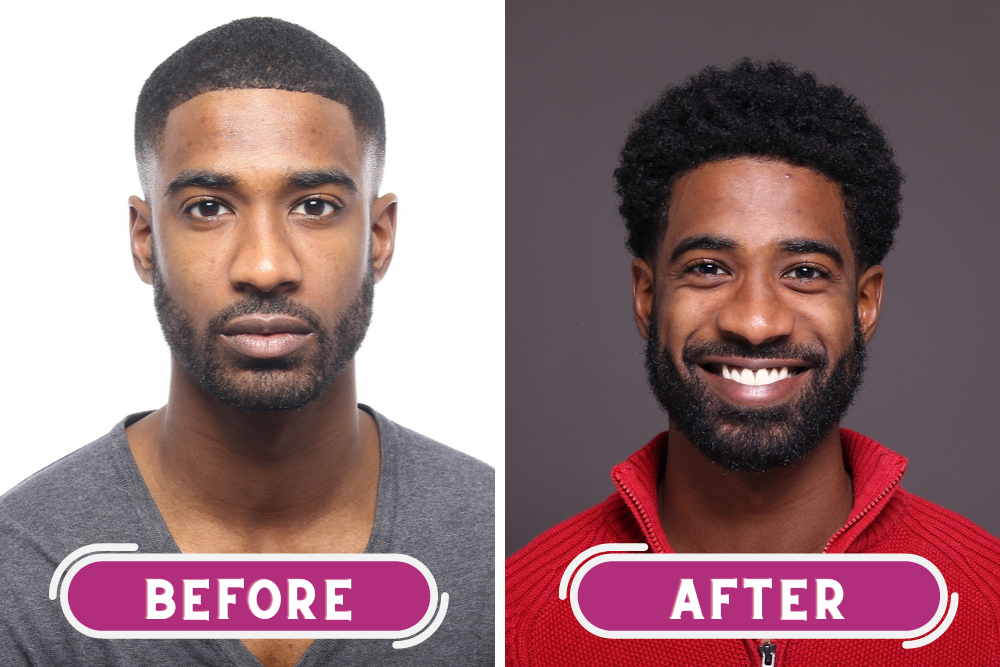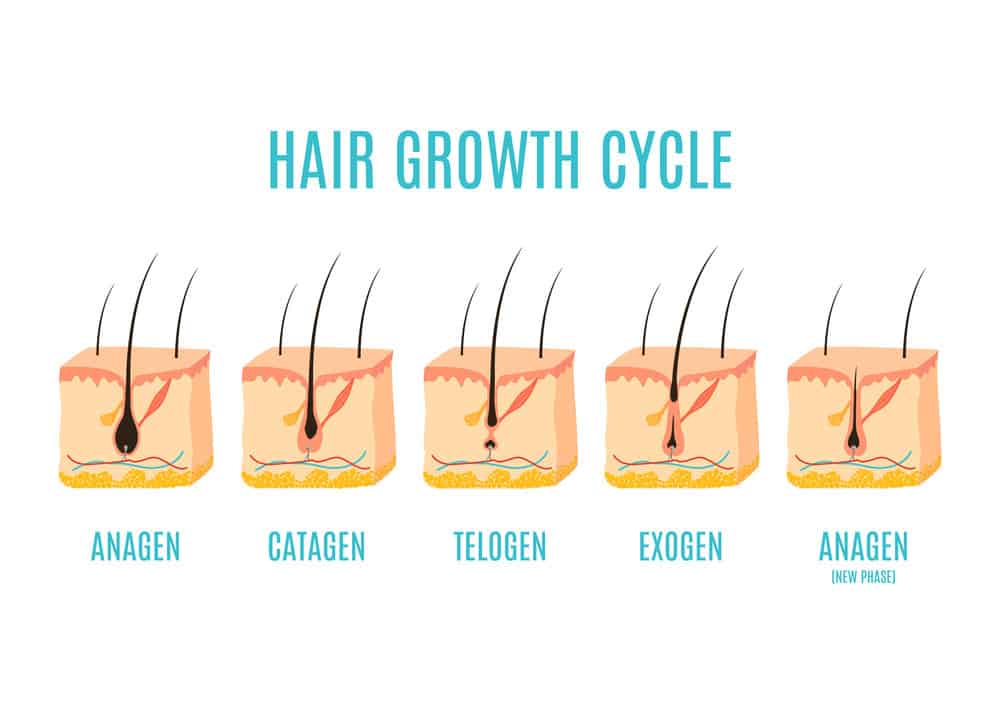
For most men, growing a beard will take time and patience. And the process is rarely smooth. Instead, growing a beard is full of awkward–and itchy–stages in which your beard may look scruffy, uneven, or patchy.
So, how long does it take to grow a beard? Whether it’s your first, second, or even third attempt at growing a full beard, we’ve got you covered!
In this article, we’ll help you figure out how long your beard will take to grow. We’ll also give you plenty of tips on maximizing beard growth, so make sure you read all the way to the end!
Table of Contents
How Long Does It Take to Grow a Beard
There’s no set length of time that it takes for a beard to grow. The average rate for hair growth depends on several different factors, including your diet, lifestyle, and genetics. The average rate for beard growth is around 0.27 mm per day. For most people, this works out to ⅓ to ½ inches each month.
So if you’re starting with a bare face, you should have a full beard within two to four months. Keep in mind that this is just the average rate of beard growth. Your beard may grow quicker or slower, depending on the other factors we mentioned earlier.

Does Shaving Help Your Beard Grow?
There’s a common misconception that shaving a beard will help it grow. Unfortunately, this isn’t the case. Shaving your hair does not stimulate hair growth and won’t impact how long it takes to get a beard.
It can, however, make it look like your beard is growing in more quickly.
When your hair grows naturally, it tapers to a fine point at the end. Alternatively, shaving a strand of hair creates a blunt, angled edge. That can make the hair look thicker and give the illusion of fuller or faster growth.
Is It Possible to Be Unable to Grow a Beard?
We’re sad to say that not everyone can grow a full beard. Studies show that as many as 50% of all men will have difficulty growing facial hair.
Even after years of doing everything right, you may find that your beard comes in patchy or sparse or can't reach a specific length. Whether you can overcome these difficulties depends on the underlying factors and if they’re reversible.

What are the Beard Growth Stages?
Now that you know your beard grows 0.27 mm daily, you might be surprised to find out that your strands aren’t continually growing.
Like the hair on your head, beard hair goes through several life stages. Below, we’ll break down the different phases and give you insight into what they mean.

Anagen
The anagen phase is one of the best-known stages in hair growth. During this period, new hairs are formed and grown.
The anagen phase is one of the longest steps in the cycle and typically lasts between two to four months. The longer your anagen phase is, the longer your beard will be able to grow.
Catagen
Once your hair leaves the anagen phase, it transitions into the catagen phase. The catagen stage is a transitional period in which your hair matures. It’s a relatively short phase lasting only a few weeks.
During the catagen phase, growth slows down, and the hair bulb separates from your follicle. After the catagen phase, your hair can either continue growing or move on to the telogen stage.
Telogen
After years of continual growth, your hair follicles enter a resting period. They stop growing and exist in a state of suspended animation.
The telogen phase lasts for an average of three to four months. While this isn’t a shedding phase, you may start losing a few strands here and there.
Exogen
The exogen phase is the fourth and final stage. When a follicle enters the exogen phase, the existing strand falls out, and a new hair forms to take its place. Once the hair falls out, the cycle begins again.

What Affects Beard Growth the Most?
As we mentioned earlier, there are a variety of factors that play a role in how long it will take for your beard to grow. We’ll walk you through them below.
- Age - Although some people can grow a full beard by as early as 18, this isn’t the norm. Most men reach their full beard growth potential in their mid-twenties. But for other men, it doesn’t occur until 30. So if you aren’t satisfied with your current beard, don’t worry; it just may not be your time yet.
- Hormone levels - Testosterone, a male growth hormone, is one of the most significant deciding factors in beard growth and growing speed. Additionally, difficulty growing a beard can be a symptom of low testosterone. So if you think that there’s a chance that your testosterone levels are lower than they should be, speak with your doctor. They may recommend supplements or get you started on hormone therapy.
- Ethnicity - Did you know that certain ethnic groups have more or less beard growth than others? Asian men tend to have the least amount of facial hair and often find it challenging to grow a full beard. On the other side of the spectrum, men of Mediterranean descent typically have thick, full beards.
- Genetics - Like male pattern baldness, your genes largely determine beard growth. For insight into what your beard will be like in the future, look to the men in your family. If full beards are common, there’s a good chance that you’ll have no problem growing out your beard. But if facial hair tends to be scant in your family, your beard might never get fuller. The good (or bad) news is that this method isn’t foolproof. While it gives you an idea of what to expect, your beard may turn out differently.

How to Speed up Beard Growth
Are you wondering if there’s anything you can do to speed up the process? Well, you’re in luck because that’s precisely what we’ll look at in this section.
Here are some of the best ways to increase how quickly your beard grows.
Massage Your Face
One easy way to speed up beard growth is to give yourself daily massages. Massages improve your blood and oxygen circulation, which drives vitamins and minerals to your hair follicles.
And the more well-fed your hair follicles are, the better growth you’ll see.
Once or twice a day spread a few drops of oil onto your fingertips and press them into your cheeks and chin. Gently rotate them in a circular motion for three or four minutes until you’ve covered the entire lower half of your face.

Exercise Regularly
You might be surprised to find out how much regular exercise can improve hair growth. Like massages, exercise improves your blood and oxygen circulation.
And as the blood travels throughout your body, it delivers growth-boosting vitamins and minerals to your hair follicles. Most adults need about 150 minutes of moderate to high-intensity aerobic activity and two days of strength or muscle training exercises each week.
Get Your Stress Levels Under Control
Stress levels are tied to everything from your immune health to your mental well-being. High or chronic stress has even been linked to hair loss and thinning.
Although you can’t get rid of stress completely, you can learn how to manage it. Looking for ways to do that?
Try adding one or more of the following stress-reducing activities to your routine.
- Meditation
- Exercise
- Yoga
- Journaling
- Socializing with loved ones

Eat a Balanced Diet
Healthy hair growth starts from the inside out, whether it’s the hair on your head or the strands on your face. You’ll need to supply your body with all the nutrients it needs to produce new hair.
That means eating a diet rich in fruits, whole grains, and vegetables and low in sugar and saturated fats. You should also opt for protein-rich foods like meats, beans, and nuts. And to top it all off, make sure you’re washing everything down with plenty of water.
Keep your Beard Clean
Although it’s easy to overlook, washing your beard is a critical part of its maintenance. If you don’t wash your beard often enough, it can develop an overgrowth of fungus and bacteria.
That can lead to issues like itchiness, breakouts, infections, and inflamed hair follicles. Not washing your beard will also leave it dull and greasy as natural oils, products, and dead skin cells build up.
It’s important to note that your beard has unique needs, so you’ll have to be careful about what you use to cleanse it.
Body soaps, facial cleansers, and regular shampoo can strip too much moisture from your strands, leaving them dry and brittle. For the best results, use a mild beard cleaner two or three times a week to keep your strands both hydrated and clean.

Moisturize your Beard Regularly
Moisturizing is a critical part of keeping your hair and skin healthy. It prevents irritated, dry skin and keeps your beard hair strong, soft, and shiny.
By comparison, dry hair is extremely brittle and prone to breaking or developing split ends. So after washing your beard, lock in all that hydration with a beard-friendly conditioner, lotion, or oil.
Get Enough Sleep Each Night
There’s no way around it: adequate sleep is a necessary part of staying healthy. When you go to sleep, your body slows down and starts the recovery process. It works on repairing and restoring your cells, so everything works as it should.
Sleep also regulates your hormone production and gives your testosterone levels a boost. So for maximum beard growth, try to get between seven to eight hours of quality sleep each night.
Quit Smoking
If you want to grow a beard and are still smoking, consider this your sign to quit. In addition to being extremely detrimental to your health, smoking negatively impacts your blood and oxygen circulation.
It essentially starves your hair follicles, which stunts hair growth. Smoking can also cause nutritional deficiencies, some of which can increase hair loss. On the bright side, most of these symptoms resolve within the first few smoke-free years.
Boost Your Testosterone
People with low testosterone almost always have little to no facial hair. So, if you want to grow a long, thick beard, you’ll have to raise your testosterone levels to a healthy level.
Start by heading to a medical provider for testing to see where your levels currently fall. You can also try incorporating more testosterone-boosting activities into your routine.
Raising your testosterone is relatively straightforward.
All you have to do is follow the other tips we’ve gone over in this section! As a refresher, some of the best ways to increase your body’s testosterone production include:
- Getting adequate sleep each night
- Eating a healthy, well-balanced diet
- Learning how to manage your stress
- Getting plenty of cardio and strength training

Do Beard Oils Work?
As you get more into beard care, you’ll come across a variety of products. One of the most popular is beard oil. Beard oils are fantastic for your beard. They do the following:
- Make your beard soft and shiny.
- Keep your hair and follicles strong and healthy enough to support healthy growth.
- Aid in styling to tame and smooth unruly strands.
In addition to being great for your hair, beard oils can work wonders on the skin underneath. Depending on which oil you use, you may see a reduction in things like skin dryness, irritation, itchiness, acne, and even ingrown hairs.
Should I Oil My Beard Every Day?
Although oiling your beard is an excellent way to keep your hair and skin healthy, you don’t want to do it every day. In addition to making your strands look greasy, the excess oil can increase breakouts, irritation, and blocked follicles.
And when left untreated, blocked follicles can lead to temporary or permanent hair loss. So, rather than oiling your beard daily, stick to oiling it two or three times a week.
If your hair still feels dry, you can increase that number to four times a week instead.
And remember, a little goes a long way when it comes to oil. So, only apply a few drops of oil at a time. Then, gently massage the oil into your beard and skin until it’s fully absorbed.
Which Oil is Best for Beard Growth and Thickness?
Are you thinking about giving beard oil a try but don't have the money for beard oil? The good news is that there are several beard-oil alternatives you can use. Below, we’ll share some of our favorite affordable growth-boosting oils.
- Coconut oil - Coconut oil is easily absorbed, reparative, and helps keep your beard strong and healthy. Another great thing about coconut oil is that it’s anti-inflammatory and anti-microbial! It encourages a healthy biome, which helps your skin stay hydrated and flake-free.
- Argan oil - Argan oil is a favorite among hair and skincare enthusiasts alike. It’s incredibly lightweight and melts into your hair without coating it in a greasy residue. Argan oil is exceptionally rich in fatty acids, which soften and hydrate parched hair and skin. Additionally, argan oil is one of the few non-comedogenic oils, meaning it won’t clog your pores or cause breakouts.
- Olive oil - It’s no secret that olive oil is one of the healthiest oils around. While it's best known for its heart-healthy effects, olive oil is just as beneficial when applied topically. It’s rich in potent nutrients that nourish your hair and skin and keep them in excellent condition.
- Jojoba oil - Unlike other oils, jojoba closely matches your skin’s natural sebum. That makes it less likely to build up on your skin and cause clogged pores or acne. Jojoba oil is packed with vitamins and minerals that encourage hair growth, thickness, and length retention.
Dos and Don'ts for Beard Growth
We get it. We’ve covered a ton of information so far, and it's a lot to remember. So in this section, we’ll walk you through a list of dos and don’ts for healthy beard growth. We’ll also throw in a few new tips that will help ensure your beard stays soft, lush, and full.
Dos
- Do be patient as your beard grows in.
- Do invest in a high-quality beard trimmer.
- Do brush your beard with a boar bristle brush daily.
- Do brush your beard in the direction you want the strands to grow.
- Do clean and replace your beard-trimming tools regularly.
- Do take hair growth-boosting supplements to maximize beard growth.
- Do exfoliate weekly to prevent clogged pores.
- Do visit your barber for regular beard care.
- Do cut your beard with trimming shears to prevent split ends and unruly strands.
Don’ts
- Don’t pick at ingrown hairs or bumps.
- Don’t neglect the skin underneath your beard.
- Don’t skip your monthly beard trims.
- Don’t use hair care products on your beard.
- Don’t forget to take care of your sideburns.
- Don’t overwash your beard.
- Don’t overload your beard with too many styling products.
- Don’t use products that contain a ton of harsh or irritating ingredients like fragrances, dyes, and alcohol.
As a reminder, a beard takes between two to four months to grow in completely. Your beard may grow quicker or take longer, depending on your lifestyle, genetic predispositions, and how well you care for your beard.
Fortunately, you can speed things up significantly with the right products and techniques. And we hope the information we’ve covered today shows you how to do just that!




